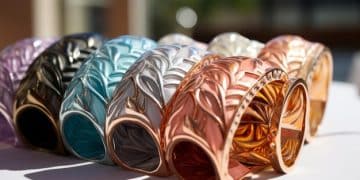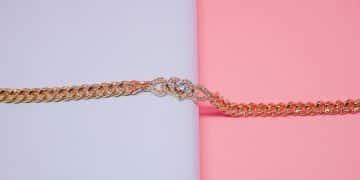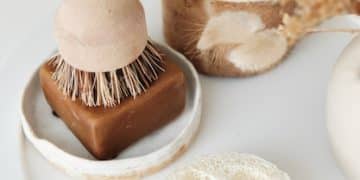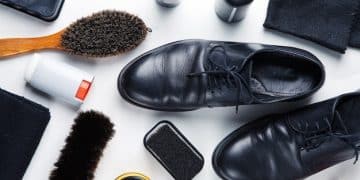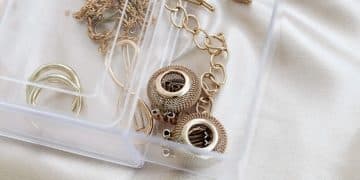How to Clean Fashion Jewelry: Restore Shine & Extend Life
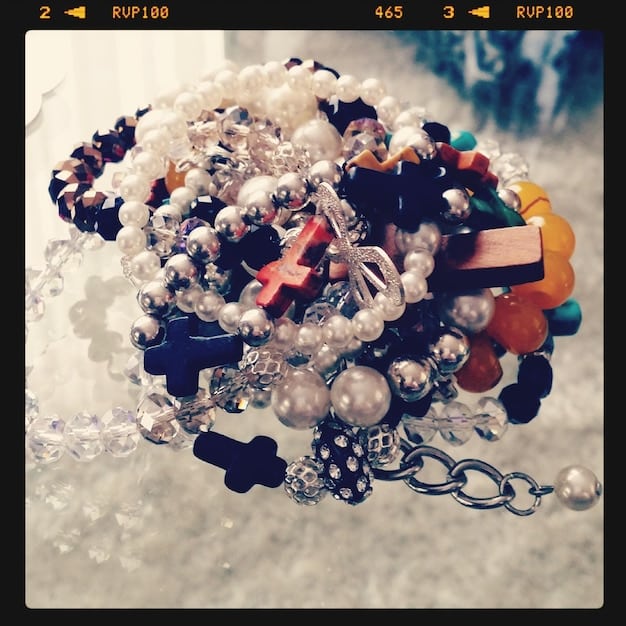
Achieving optimal longevity and shine for fashion jewelry requires consistent, careful cleaning techniques tailored to material vulnerabilities to prevent damage and discoloration.
Fashion jewelry, with its diverse materials and intricate designs, offers an accessible way to elevate any outfit. However, unlike their fine jewelry counterparts, these pieces often require a more nuanced approach when it comes to maintenance. Have you ever wondered How to Clean Fashion Jewelry: A Step-by-Step Guide to Restoring Shine?
While the allure of a new, sparkling piece often captivates us, the reality is that daily wear exposes it to a myriad of elements—skin oils, lotions, perfumes, daily grime, and even air pollutants. These elements can quickly dull its luster, leading to discoloration, tarnishing, and a visible loss of its initial charm. Therefore, understanding the proper cleaning methods isn’t just about aesthetics; it’s about preserving your investment, no matter how modest, and ensuring these accessories continue to bring joy and complete your style for years to come. This comprehensive guide will equip you with the knowledge and practical steps necessary to restore and maintain the brilliance of your beloved fashion jewelry, transforming dull back to dazzling.
Understanding Your Fashion Jewelry Materials
Before embarking on any cleaning endeavor, it is paramount to understand the specific materials your fashion jewelry is made from. Unlike solid gold or sterling silver, fashion jewelry often incorporates a blend of base metals, plating, adhesives, and various embellishments, each with its own sensitivities. Mishandling can lead to irreversible damage, such as dulling, discoloration, or even dissolution.
Common base metals include brass, copper, and alloys, which are typically plated with a thin layer of gold, silver, rhodium, or other finishes. These platings are delicate and can wear off with abrasive cleaning or harsh chemicals. It’s crucial to identify if your piece is plated, as this dictates the gentleness required in the cleaning process. Many pieces also feature synthetic gemstones, glass, plastic, pearls, or enamel. Each of these materials reacts differently to moisture and cleaning agents; for instance, porous stones or natural pearls can be damaged by prolonged water exposure or strong solutions, as can glued components.
Knowing your materials allows you to select the appropriate cleaning agents and methods, ensuring effective restoration without compromising the integrity of the piece. Always err on the side of caution with fashion jewelry, as its beauty often lies in its delicate construction.
Common Metals and Materials
The foundation of most fashion jewelry pieces often consists of a range of common elements that dictate much of its durability and how it reacts to cleaning. It is common to find pieces made from:
- Brass: A copper-zinc alloy that can tarnish over time, often used as a base for plating.
- Copper: Known for its reddish-brown hue, it also tarnishes, forming a greenish patina.
- Alloys: Mixtures of various metals, which can be difficult to identify without specific tools but are generally treated as delicate.
- Plating: Thin layers of gold, silver, or rhodium applied over base metals. This layer is what gives the jewelry its desired metallic look without the cost of solid precious metals.
Sensitive Components
Beyond the metals, many fashion jewelry items feature sensitive components that require even more careful handling. These include:
- Glass or Acrylic Stones: These synthetic gems are usually glued in place and can become loose if exposed to excessive water or strong cleaning solutions.
- Pearls (Natural and Simulated): Both types are porous and can lose their luster or even degrade with exposure to chemicals, acids, or prolonged water immersion.
- Enamel and Resin: These decorative coatings can be damaged by abrasive cleaners or solvents, leading to chipping or discoloration.
- Adhesives: Glued parts, common in fashion jewelry assembly, are particularly vulnerable to moisture and chemical agents that can weaken the bond.
Proper identification of these components is your first line of defense against accidental damage. If uncertain about a material, always opt for the gentlest cleaning method possible, focusing on surface dirt removal rather than deep cleaning. This cautious approach ensures the longevity and preservation of the piece’s original appearance.
Essential Tools and Gentle Cleaning Agents
To effectively clean your fashion jewelry without causing damage, selecting the right tools and cleaning agents is crucial. The goal is to remove grime and restore shine using methods that are gentle yet effective, especially given the common use of plating, adhesives, and delicate stones in these pieces.
Start with soft, lint-free cloths, such as microfiber or chamois, which are ideal for buffing and drying without scratching. Cotton swabs are invaluable for reaching small crevices and detailed areas. For brushing, opt for a very soft-bristled toothbrush or an old, soft makeup brush, as anything too abrasive can strip plating or scratch surfaces. A small, non-metallic bowl or dish will be needed for soaking if applicable. Remember, the gentler the tool, the safer it is for your jewelry.
When it comes to cleaning agents, simple solutions often work best. Mild dish soap (like a gentle dishwashing liquid without strong detergents or degreasers) mixed with lukewarm water is a go-to for most fashion jewelry. This creates a gentle, soapy solution that effectively breaks down oils and dirt without being overly harsh. For specific issues like light tarnish, a baking soda paste can be considered, but only with extreme caution and on appropriate materials, avoiding plated items. When selecting a cleaning agent, always prioritize those labeled as mild or gentle, and avoid anything with ammonia, bleach, or harsh abrasives, as these can easily damage delicate platings, glues, and certain stones. Homemade solutions are often safer than commercial jewelry cleaners, which are typically formulated for fine watches and jewelry and may be too aggressive for the sensitive components of fashion jewelry.
Tools Every Jewelry Owner Needs
Having the right arsenal of tools can make all the difference in safely maintaining your fashion jewelry. Here’s what you should have on hand:
- Soft Bristle Brush: A baby toothbrush or a very soft artist’s paint brush is perfect for gently dislodging dirt from crevices without scratching.
- Microfiber Cloths: Essential for drying and buffing, these cloths are non-abrasive and highly absorbent, preventing water spots and restoring shine.
- Cotton Swabs: Ideal for precision cleaning in tight spaces or applying cleaning solutions to specific areas.
- Small Non-Metallic Bowl: For mixing gentle cleaning solutions and soaking items. Avoid metal bowls that could react with the cleaning agents or the jewelry.
Using the correct tools minimizes the risk of inadvertently damaging your pieces. The key is gentle application and soft materials that won’t scratch or abrade delicate surfaces or plating. Always ensure your tools are clean before use to avoid transferring new dirt or debris onto your jewelry.
Effective and Safe Cleaning Solutions
Choosing the appropriate cleaning solution is just as important as the tools. For most fashion jewelry, simplicity is best:
- Mild Dish Soap and Lukewarm Water: This is the safest and most widely applicable cleaning solution. Mix a few drops of mild dish soap into a bowl of lukewarm, not hot, water. This solution effectively dissolves oils and loosens superficial dirt.
- Baking Soda Paste (Use with Caution): For very light tarnish on unplated metals that can withstand gentle abrasion, a paste of baking soda and a few drops of water can be used sparingly. Gently rub with a finger or cotton swab, then rinse and dry thoroughly. Avoid this on plated items, pearls, or soft stones.
- Jewelry Polishing Cloths (Specific Types): There are cloths specifically designed for fashion jewelry that can remove light tarnish and buff surfaces. Ensure they are for fashion or costume jewelry, not fine jewelry, as the latter might contain polishing agents too strong for delicate platings.
Remember to avoid harsh chemicals like ammonia, bleach, rubbing alcohol (unless specifically recommended for a certain material without glue), or abrasive cleaners. These can strip finishes, dissolve adhesives, or pit certain stones. Always test a small, inconspicuous area first if you are unsure about a cleaning agent’s compatibility with your specific piece of jewelry. The goal is to clean gently, not to strip or damage the delicate surfaces.
Step-by-Step Cleaning Process for Most Fashion Jewelry
Cleaning fashion jewelry requires a gentle, systematic approach to ensure effectiveness without causing damage. Begin by preparing your cleaning station, gathering a small bowl, mild dish soap, lukewarm water, a soft brush (like a baby toothbrush), and a microfiber cloth. This structured approach helps maintain the integrity of your beloved pieces.
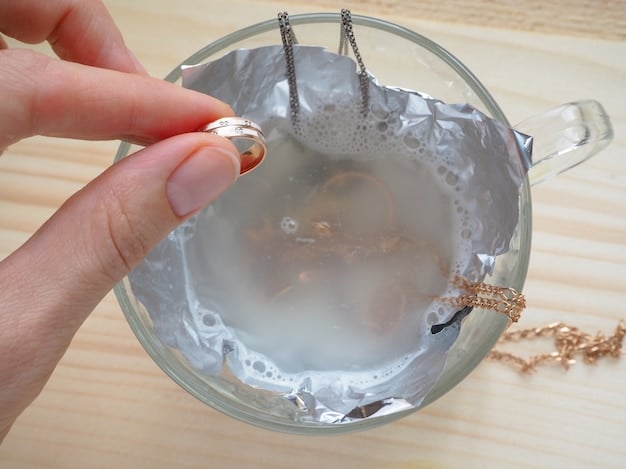
Preparation and Initial Assessment
Before any cleaning begins, it’s essential to prepare and assess your jewelry. Lay out a soft cloth or towel to protect your work surface and the jewelry itself. Carefully examine each piece for any loose stones, broken clasps, or signs of extreme wear where plating might be completely gone. This preliminary check helps you identify areas that might need extra care or if the piece is too fragile for even gentle cleaning.
For pieces with heavily encrusted dirt or significant tarnish, a pre-soak can be beneficial, but only if the materials are suitable. For most fashion jewelry, avoid prolonged soaking, especially if it contains glued components, pearls, or highly porous stones. A quick dip or gentle wipe with a damp cloth may be all that is needed for initial surface grime removal.
The Gentle Washing Method
The core of cleaning fashion jewelry lies in a gentle washing method. Create a solution of a few drops of mild dish soap in a bowl of lukewarm water. Avoid hot water, which can damage softer stones or dissolve adhesives. Submerge the jewelry briefly—for no more than a few seconds or a minute—if it’s free of porous stones, pearls, or delicate glues. If unsure, simply dip your soft brush into the solution and gently scrub the jewelry instead of submerging the piece itself.
Carefully brush the piece with your soft-bristled brush, paying attention to crevices and areas where dirt tends to accumulate. For intricate details, cotton swabs dipped in the soapy water can be very effective. Be extremely gentle around any glued components or delicate embellishments. The aim is to loosen dirt, not to scrub aggressively, which could scratch the surface or remove plating.
After scrubbing, rinse the jewelry under a gentle stream of cool or lukewarm water. Ensure all soap residue is removed, as any lingering soap can cause spots or attract new dirt. Immediately after rinsing, gently pat the jewelry dry with a clean, lint-free microfiber cloth. For pieces with many crevices, you might need to use a hairdryer on a cool setting for a few seconds to ensure absolute dryness, as lingering moisture can lead to tarnishing or damage over time. Always ensure the piece is completely dry before storing it.
Targeted Cleaning for Specific Materials and Conditions
While the gentle dish soap method works for most fashion jewelry, certain materials and conditions necessitate more targeted approaches. Addressing issues like tarnishing on specific metals, cleaning delicate pearls, or dealing with glued embellishments requires tailored care to prevent damage and optimize results.
Understanding these nuances ensures your cleaning efforts are both effective and safe for your unique pieces, extending their lifespan and maintaining their beauty.
Tarnished Metals (Gold, Silver, and Copper Plated)
Tarnish, a dulling or discoloration, often affects plated jewelry due to oxidation. For lightly tarnished silver-plated or gold-plated pieces, avoid abrasive cleaners or harsh chemical dips, which can strip the thin plating. Instead, use a specialized jewelry polishing cloth designed for plated materials. These cloths are impregnated with gentle cleaning agents and are effective for buffing away light tarnish and restoring shine without removal of the plating.
For copper-plated jewelry showing green oxidation, a very mild solution of white vinegar and salt can be used, but only apply it swiftly and gently with a cotton swab, then rinse immediately and thoroughly. Always test on an inconspicuous area first. If the tarnish is heavy or the plating is already wearing thin, it may be best to accept the piece’s natural aging process or consult a professional, as aggressive cleaning will only exacerbate the issue. Sometimes, less is more when dealing with delicate plating.
Delicate Stones and Glued Embellishments
When cleaning fashion jewelry with delicate stones (like pearls, opals, or turquoise) or glued embellishments (rhinestones, plastic components), water immersion should be avoided. Instead, dampen a soft cloth or cotton swab with plain lukewarm water or a very diluted mild dish soap solution, squeezing out all excess liquid. Gently wipe down the surfaces of the stones and around glued areas, making sure not to saturate the adhesive or porous stones. For pearls, simply wipe them clean with a soft, damp cloth after each wear to remove oils and residues, then buff dry with a dry, soft cloth. Never use harsh chemicals, ultrasonic cleaners, or abrasive polishes on these components, as they can dissolve glues, pit stones, or permanently damage their surface. The key is minimal moisture and gentle action to lift dirt without compromising the integrity of these sensitive elements.
Drying and Polishing for Maximum Shine
The drying and polishing phases are just as critical as the cleaning itself when it comes to restoring fashion jewelry. Inadequate drying can lead to water spots and accelerated tarnishing, while proper polishing enhances the shine and protects the surface. These final steps ensure your jewelry not only looks clean but truly sparkles.
Once cleaning is complete, regardless of the method, thorough drying is paramount. Use a clean, lint-free microfiber cloth to gently pat and blot every surface of the jewelry. Avoid rubbing vigorously, especially on plated items, as this can wear down the finish. For intricate pieces with many nooks and crannies, consider using a hairdryer on its cool or lowest heat setting, holding it a few inches away from the piece. This helps evaporate any trapped moisture that could otherwise cause tarnishing or damage over time, particularly in areas difficult to reach with a cloth. Ensuring complete dryness is the best defense against immediate re-tarnishing.
After the jewelry is completely dry, a gentle polishing can bring out its maximum shine. Use a dry microfiber cloth or a specialized jewelry polishing cloth (ensuring it’s suitable for fashion jewelry, not just fine metals). Gently buff the surfaces in small, circular motions. This action not only enhances the luster but also helps remove any lingering smudges or fingerprints. For added protection, some jewelry owners might consider a very thin, even layer of jewelry lacquer or clear nail polish on the underside of rings or bracelets that come into direct contact with skin. This can create a barrier against skin oils and environmental factors, extending the life of the plating and preventing green skin discoloration, but it should be applied sparingly and carefully, as it’s not suitable for all pieces or surfaces.
Preventative Care and Proper Storage
Beyond cleaning, the longevity and brilliance of your fashion jewelry largely depend on consistent preventative care and proper storage. These practices minimize exposure to damaging elements, reduce the need for frequent deep cleaning, and ultimately preserve the aesthetic appeal of your pieces for years to come.
The cardinal rule of prevention is to apply lotions, perfumes, hairspray, and cosmetics before putting on your jewelry. These products contain chemicals that can accelerate tarnishing or degrade delicate materials and platings. Similarly, remove all fashion jewelry before swimming (in chlorine or saltwater), showering, bathing, or engaging in strenuous physical activity. Moisture, chlorine, and sweat are notorious for causing discoloration and damage. Even simple tasks like washing dishes can be detrimental; excess water and harsh soaps can erode finishes and loosen stones.
Proper storage is equally vital. Air, humidity, and light contribute to tarnishing and material degradation. Store your fashion jewelry in a cool, dry place, away from direct sunlight. Individual soft pouches or compartments within a jewelry box are ideal. This prevents pieces from rubbing against each other, which can cause scratches or wear away plating. Anti-tarnish strips or silica gel packets can be placed in storage areas to absorb moisture and reduce oxidation, offering an extra layer of protection, particularly valuable for silver-plated items. By embracing these simple, proactive habits, you can significantly extend the life and maintain the sparkle of your cherished fashion jewelry, ensuring it remains delightful to wear for many seasons.
Preventative measures are the first line of defense against damage and wear on your fashion jewelry. By incorporating simple habits into your daily routine, you can significantly extend the life of your pieces and minimize the need for frequent deep cleaning. Here are the most crucial practices:
- “Last On, First Off”: Always apply perfumes, lotions, hairspray, and makeup before putting on your jewelry. The chemicals in these products can react with metals and stones, causing discoloration and degradation.
- Avoid Water Exposure: Remove your fashion jewelry before showering, swimming (especially in chlorinated water or saltwater), washing dishes, or engaging in any activity where it might get wet. Moisture is a primary culprit for tarnishing and can loosen glued components.
- Remove During High Activity: Take off jewelry when exercising, cleaning, or performing any strenuous activities. Sweat, friction, and potential impacts can cause damage.
These simple steps create a protective barrier between your jewelry and common damaging agents, ensuring that it remains as beautiful as the day you acquired it. Consistency in these habits is key to long-term preservation.
Optimal Storage Solutions
The way you store your fashion jewelry plays a pivotal role in preventing damage and preserving its luster. Proper storage protects against environmental factors that can accelerate wear and tarnishing. Consider these optimal solutions:
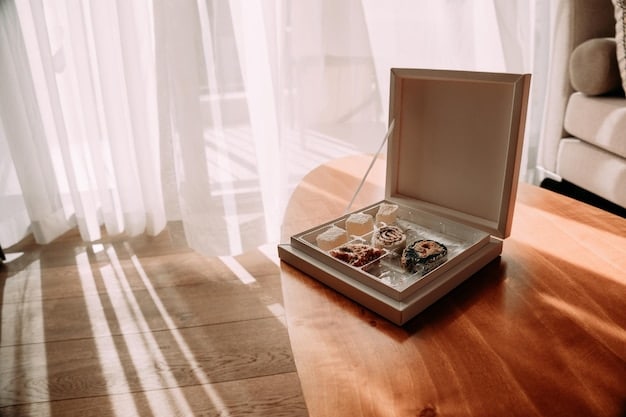
- Airtight Containers or Bags: Store individual pieces in small, airtight plastic bags (like Ziploc bags) or velvet pouches. This minimizes exposure to air and humidity, which are primary causes of tarnish.
- Cool, Dry, Dark Place: Keep your jewelry box or storage containers away from direct sunlight, heat, and high humidity. Areas like bathrooms are generally not ideal due to fluctuating humidity levels.
- Separate Compartments: If using a jewelry box, choose one with multiple compartments or line it with soft fabric. This prevents pieces from scratching each other or their platings rubbing off due to contact.
- Anti-Tarnish Strips: Place anti-tarnish paper strips (available online or at jewelry supply stores) inside your storage containers. These strips absorb airborne pollutants that cause tarnishing, offering an extra layer of protection, particularly for silver-toned pieces.
By implementing these storage strategies, you create an optimal environment for your fashion jewelry, significantly extending its lifespan and keeping it ready to wear whenever you desire. Investing a little time in proper storage now can save you much more effort and expense in cleaning and repairs later.
| Key Aspect | Brief Description |
|---|---|
| 🔬 Material Check | Identify materials (plated vs. solid, stone type) to choose safe cleaning methods. |
| 🧼 Gentle Cleaning | Use mild soap and lukewarm water; avoid harsh chemicals and excessive scrubbing. |
| 💧 Thorough Drying | Pat dry completely with a microfiber cloth; use cool air for crevices. |
| 📦 Smart Storage | Store in airtight bags or separate compartments to prevent tarnish and scratches. |
Frequently Asked Questions about Fashion Jewelry Care
▼
It is generally not recommended to use ultrasonic cleaners for fashion jewelry. The vibrations can loosen glued components, cause damage to delicate stones like pearls or opals, or even accelerate the wear of thin platings. Stick to the gentle hand-washing methods described in this guide for safer results.
▼
The frequency depends on how often you wear the piece. For frequently worn items, a quick wipe down after each wear and a gentle cleaning every few weeks is ideal. For occasional pieces, cleaning before storage and after wear should suffice. Always assess visible grime and dullness.
▼
Yes, fashion jewelry made from base metals like copper can react with your skin’s acidity or sweat, causing a greenish discoloration. While not harmful, it can be annoying. Cleaning regularly and applying a clear coat of nail polish to the skin-facing surfaces can help prevent this.
▼
For heavily tarnished fashion jewelry, especially plated items, aggressive cleaning can worsen the problem by removing the thin layer of plating. Instead of harsh methods, try a gentle buff with a specialized polishing cloth. If the tarnish is deeply set, sometimes it’s best to accept it or consider professional re-plating if the piece is valuable to you.
▼
No, most home remedies like toothpaste are not safe for fashion jewelry. Toothpaste is abrasive and can scratch delicate platings and surfaces, or even damage softer stones. Stick to very mild, non-abrasive cleaning solutions such as diluted dish soap and water, as these are much safer for the diverse materials found in fashion jewelry.
Conclusion
Maintaining the sparkle and extending the life of your fashion jewelry is a manageable endeavor that primarily revolves around understanding its unique material composition and adopting consistent care practices. By eschewing harsh chemicals and abrasive tools in favor of gentle methods—like mild soap, lukewarm water, and soft cloths—you can effectively remove everyday grime and prevent premature wear. Furthermore, diligent preventative measures, such as applying products before adorning your pieces and storing them properly, act as a vital safeguard against environmental damage and tarnish. Ultimately, a little attentiveness goes a long way in preserving the beauty and longevity of your beloved fashion accessories, ensuring they continue to complement your style with their enduring charm.
